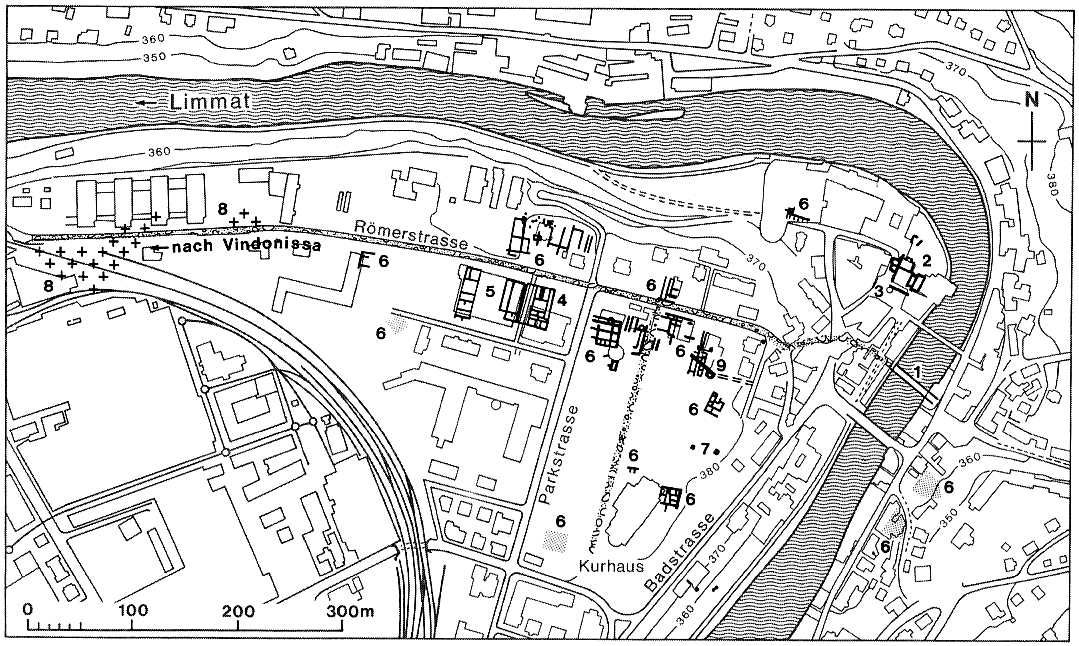Introduction
Houses and workshops
Baths
Religion
The silver hoardBaden, today with some twenty thousand inhabitants, is situated on the river Limmat, in the east part of Aargau. It was named after hot sulfur springs. Here the road coming from Windisch (Vindonissa) to the west forked, continuing towards Zürich (Turicum) and Winterthur (Vitudurum). The ancient name of the town also referred to the healing springs: Aquae Helveticae.
The old centre of Baden. Photo: Wikimedia, Johannes Menzel.Roman remains were noted as early as the 15th century. The first excavations took place in the 19th century, leading to the discovery of houses, workshops, and tombs. The lay-out of the city thus became clear, in a bend of the river, with a bridge and north-south / east-west running streets flanked by porticoes. The vicus must have measured some 550 x 300 m. The main public buildings and temples have not yet been found.

Plan of Baden with the location of Roman remains. Drack-Fellmann 1988, Abb. 327.
1: bridge; 2: baths; 3: Verenabad; 4: hospital or house of a physician; 5: houses and workshops; 6: buildings; 7: pottery workshop; 8: burials; 9: fortification.The town was founded in the years 17-20 AD, directly after the construction of the nearby military camp Vindonissa. A layer resulting from fire has been found in several places. It must be linked to events concerning the town as described by Tacitus in the Histories: the half-timbered buildings were sacked in 69 AD, the Year of the Three Emperors.
Plus praedae ac sanguinis Caecina hausit. Inritaverant turbidum ingenium Helvetii, Gallica gens olim armis virisque, mox memoria nominis clara, de caede Galbae ignari et Vitellii imperium abnuentes. Initium bello fuit avaritia ac festinatio una-et-vicensimae legionis; rapuerant pecuniam missam in stipendium castelli quod olim Helvetii suis militibus ac stipendiis tuebantur. Aegre id passi Helvetii, interceptis epistulis, quae nomine Germanici exercitus ad Pannonicas legiones ferebantur, centurionem et quosdam militum in custodia retinebant. Caecina belli avidus proximam quamque culpam, antequam paeniteret, ultum ibat: mota propere castra, vastati agri, direptus longa pace in modum municipii extructus locus, amoeno salubrium aquarum usu frequens; missi ad Raetica auxilia nuntii ut versos in legionem Helvetios a tergo adgrederentur. There was even more looting and bloodshed on Caecina's march. The Helvetii, a Gallic tribe once famous as fighting men and still distinguished by the memory of their past, having heard nothing of Galba's murder, refused to acknowledge the authority of Vitellius. This exasperated Caecina's headstrong nature. Hostilities broke out owing to the greed and impatience of the Twenty-first legion, who had seized a sum of money which was being sent to pay the garrison of a fort in which the Helvetii used to keep native troops at their own expense. The Helvetii, highly indignant at this, intercepted a dispatch from the German army to the Pannonian legions, and kept a centurion and some men in custody. Greedy for battle, Caecina hastened to take immediate vengeance without giving them time for second thoughts. Promptly breaking up his camp, he proceeded to harry the country, and sacked a charming and much-frequented watering-place, which had grown during the long peace into the size and importance of a town. Instructions were sent to the Raetian auxiliaries to attack the Helvetii in the rear, while their attention was occupied with the legion. Tacitus, Histories I,67. Translation W. Hamilton Fyfe. The town was rebuilt and flourished in the late first and second century AD. It was destroyed again around 250 AD, but was populated once more. Remains have been discovered of a fortification wall and of a tower from the fourth century. The latest coins have been dated to around 380 AD. Countless objects were found during the excavations, of which a small selection is presented here. They were taken to the Historisches Museum in Baden (the Landvogteischloss), the Vindonissa Museum in Brugg, and the Landesmuseum in Zürich.
Introduction
Houses and workshops
Baths
Religion
The silver hoard
Literature
Stähelin 1931, 553 (with older literature); Drack 1944(3); Drack 1946; Simonett 1946; Drack 1950, 57-58; Berger 1957; Wiedemer 1967(1); Mittler 1968; Wiedemer 1969; Doppler 1969; Doppler 1970; Unz 1971; Doppler 1972; Hartmann 1973; Unz 1974; Doppler 1976; Hartmann 1980(1); Doppler 1983; Schucany 1983; Fünfschilling 1985; Hartmann-Weber 1985, 161-164, 206-207; Drack-Fellmann 1988, 348-353, 536-537; Holliger-Holliger 1989; Koller 1989; Drack-Fellmann 1991, 65-67, 275; Schucany 1996(1); Schucany 1998; Neukom 2002; Deschler-Erb et al. 2005; Schaer 2010; Bürge et al. 2013, 41-48; Frei-Stolba - Hartmann - Flück 2022.
[31-Aug-2023]